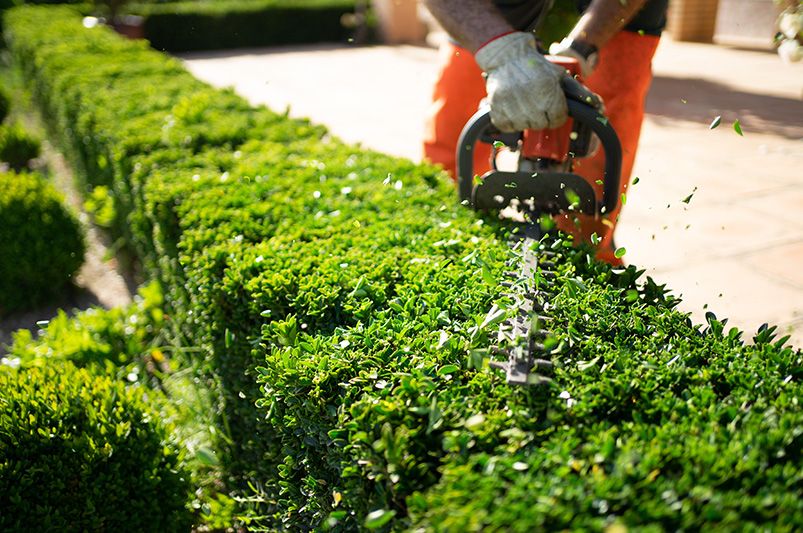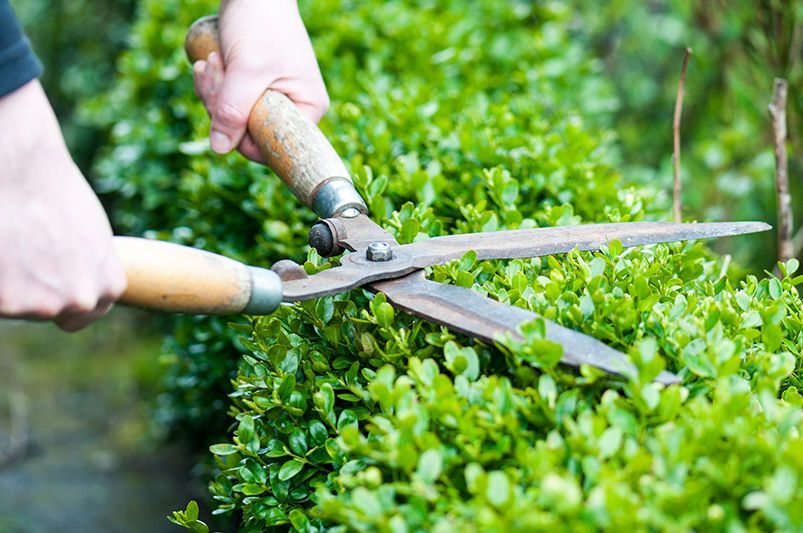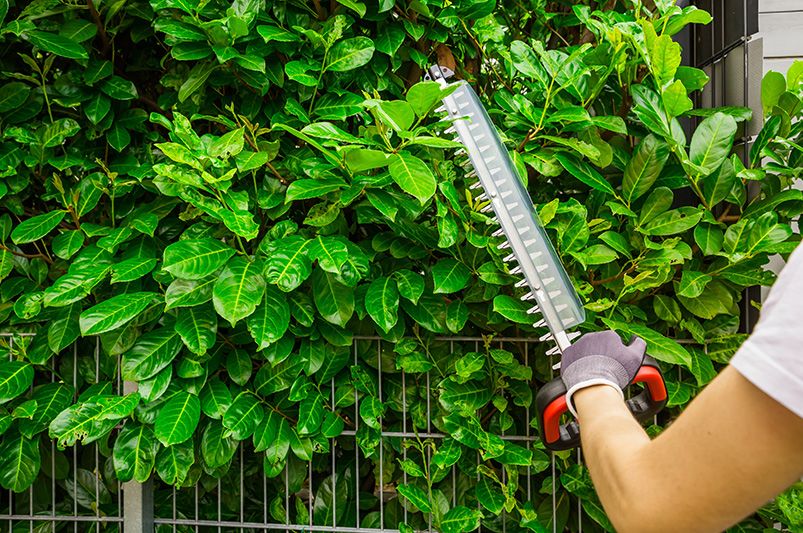
Essential Tips for Trimming Hedges: A Beginner's Guide
Published: 23/08/2024 | Updated: 23/08/2024
Key Highlights
- Timing is crucial: Trim hedges based on their type and blooming season. Spring-flowering hedges are best trimmed after blooming, while summer-flowering ones prefer a late winter or early spring trim.
- Sharp tools are essential: Invest in quality hand shears, hedge trimmers, and a pruning saw for clean cuts that promote healthy growth.
- Safety first: Always wear safety gear, including gloves and eye protection, when trimming hedges.
- Understanding the difference: Trimming maintains a hedge's shape, while pruning removes dead or overgrown branches.
- Regular maintenance is key: Frequent, light trimming is healthier for your hedges than occasional heavy pruning.
Introduction
Having a well-kept hedge can really improve how your yard looks. It’s important to know when and how to trim hedges for their health and look. Whether you have lots of gardening experience or are new to it, this guide gives useful tips and ways to trim hedges. It covers choosing the right hedge trimmer and getting those perfect shapes. We will talk about the best methods, the right time—early spring is a great time for many hedges—and common mistakes to avoid. This way, your hedges can flourish for a long time.


Understanding Hedge Trimming
Hedge trimming is important for keeping your hedges in the right shape and size. It goes beyond just making your garden look good. Trimming your hedges regularly helps them grow thick and healthy. It stops them from getting too big and messy.
You can think of trimming like giving your hedges a haircut. Just as you get regular trims to keep your hair neat and healthy, doing the same for your hedges helps them grow well. Trimming keeps their shape, stops them from blocking paths or buildings, and lets sunlight reach all parts of the plants. This helps them grow strong and healthy.
The Importance of Regular Hedge Maintenance
Regular hedge maintenance is key to having a healthy and attractive hedge. When you trim your hedges often, it encourages new growth. This makes the hedge fuller and nicer to look at. If you wait too long to trim, your hedges may become overgrown and hard to manage. You might then need to do severe pruning.
So, why is healthy growth important for hedges? A thick, healthy hedge gives you more privacy. It also acts as a natural wind barrier and makes your garden look better.
In addition, keeping up with hedge maintenance helps you find problems early. When you trim your hedges, you can look for signs of diseases, pests, or nutrient issues. If you see any, you can treat them right away, which helps to stop more damage.

Differences Between Trimming and Pruning
Though people often use the words trimming and pruning the same way, they are different parts of taking care of hedges. Trimming is about cutting the outer growth lightly. This helps keep the hedge looking neat and encourages it to become bushy. You usually use hedge trimmers or hand shears for trimming.
Pruning is a deeper process. It aims to take away dead, sick, or overgrown branches. This helps the health and structure of the hedge. Pruning tools like pruning saws and loppers work best since they can cut thicker branches.
When you trim hedges, it’s like giving them a haircut to keep a certain style. Pruning is more like surgery because it removes unwanted or sick parts to help the plant stay healthy overall.
Preparing to Trim Your Hedges
Before you start trimming, it is very important to get all the tools you need and to create a safe place to work. Having the right tools makes the job easier and helps you get better results. Also, knowing how to use the tools safely helps you avoid accidents and makes the trimming go better.
Always check your tools before you begin. Make sure the blades are sharp. Dull blades can crush branches. This can cause uneven cuts and may lead to disease.
Essential Tools for Hedge Trimming
Having the right tools can make trimming hedges easier and quicker. Here are the main tools you need for hedge trimming:
- Hand shears: Great for cutting smaller branches in tight spots where a hedge trimmer can't go.
- Electric hedge trimmer: A strong tool for cutting large hedges or thicker branches. They come in different sizes, so pick one that matches your hedge size and feels comfortable for you.
- Pruning saw: Good for taking off thicker, dead branches that shears or trimmers cannot cut.
Besides these tools, using a strong pair of gardening gloves will keep your hands safe from thorns and blisters. Also, wearing safety glasses will protect your eyes from flying debris.
Safety Gear and Precautions
Trimming hedges may look simple, but it can be risky. Using sharp tools can lead to harm if not used carefully. That's why wearing the right safety gear is very important.
Always put on strong gardening gloves. They help protect your hands from thorns, blisters, or annoying sap. Safety glasses are also important. They keep flying bits of debris from hurting your eyes.
Keep in mind that open wounds can get infected while you garden. It's best to skip trimming if you have cuts or sores on your hands or arms. If you really need to trim, make sure to cover any wounds with a waterproof bandage and always wear gloves for extra safety.
Beginner's Guide to Hedge Trimming
Trimming your hedge for the first time may feel scary. But, if you take a step-by-step approach and learn the basics, it can be easy. First, you need to figure out what type of hedge you have. Different hedges grow in different ways, and each one needs its own trimming method.
After you know the type of hedge, you can plan how to trim it. Gather the right tools you need and start shaping your hedges like an expert.
Identifying Your Hedge Type
The first step in trimming hedges successfully is to know what type you have. Hedges are mainly evergreen or deciduous. Evergreen hedges, like boxwoods and yews, keep their leaves throughout the year. This gives you a steady green look. Deciduous shrubs, however, lose their leaves in the fall but show beautiful colors during autumn.
Each type needs a different way of trimming. Evergreens grow all the time, so they need light trims often to keep their shape. Deciduous shrubs require careful pruning after they bloom to encourage healthy growth.
It’s also important to know the hedge's natural shape. Some hedges grow roundly or in a pyramid shape. By identifying this, you can trim them following their natural lines. This makes them look nicer and helps you avoid unnecessary cuts.
Step 1: Planning Your Approach
Before you start trimming, think about how you want it to look. Do you want a formal hedge with sharp, straight edges, or do you like a more relaxed, natural style? This will decide how you trim.
- Formal Hedge: If you want a formal look, use stakes and string to help you. This will keep your lines straight. This is very important for the top of the hedge because it can be hard to keep the height even without support.
- Informal Hedge: For a natural look, follow the shape of the shrub. Make the base a bit wider than the top. This will help sunlight reach the lower branches so they can grow well from the ground level.
Remember, trimming helps new growth. Plan your cuts to keep enough healthy foliage so your hedge stays thick and lively.
Step 2: Basic Trimming Techniques
Once you have a simple plan, it's time to start trimming. If you want a straight edge, use a string line tied between stakes. This will help you keep a steady guide and avoid an uneven top.
For clean cuts, angle your cuts slightly upward. This will help water flow off the cut surface and lower the chance of disease. Don't leave stubs because they can let in pests or diseases. Use hand pruners for smaller branches and hedge trimmers for larger areas.
Make sure to step back often and check how you're doing. It's easier to take off more later than to fix a section that is trimmed too much.

Step 3: Shaping and Styling
Shaping your hedge is a time to show your creativity. You can change it into an eye-catching part of your garden. When you shape your hedge, think about how it grows naturally and the style of your garden.
For a formal hedge, it's important to keep clear lines and balanced shapes. Trim softly along the sides and the top. You can use string lines to help you keep straight edges. If you want a more natural look, follow how the plant grows. Trim here and there to highlight its current shape.
Remember, shaping your hedge is not about forcing it into a certain look. It’s about working with how it grows to make it more beautiful. This could be a clean, tidy appearance or a more relaxed, natural style.
Step 4: Cleaning Up
Once you finish trimming and shaping, cleaning up is very important. It helps to keep everything looking nice and supports healthy growth. Lay a tarp under the hedge to catch the clippings. This makes cleaning easier. If you don’t have a tarp, you will need to rake up the clippings well after trimming.
Be sure to get rid of the clippings properly. Don't leave them piled at the hedge's base. This can choke the roots and cause diseases. You can add the clippings to your compost pile or throw them away based on local rules.
Cleaning up after trimming is not just for looks. It is a key step to stop pests and diseases, helping your hedge stay healthy and vibrant.
Advanced Tips for Perfect Hedges
Keeping your hedges looking perfect goes beyond just simple trimming. You also need to deal with specific issues, like hedges that are too tall or need some new growth. This requires planning and attention to detail.
Also, knowing how to care for your hedges in different seasons is important for their health. Each season needs a different care plan. Adjusting your trimming based on the time of year can help your hedge live longer and look more beautiful.
Dealing with Overgrown Hedges
Overgrown hedges can seem hard to manage, but you can bring them back with the right steps. If your hedges have grown too much over several seasons, you may need to prune them more aggressively. This means cutting them back a lot to help them grow fresh and healthy.
First, look for old wood. This wood is usually thicker and darker than the new growth. Cut these branches back to the base or to a healthy side shoot. Don’t worry about cutting back a lot, because this will let more sunlight into the center of the hedge, helping it to rejuvenate.
But remember, don’t remove more than one-third of the plant in one year. If your hedge needs a lot of trimming, spread the work over two or three years. This will help reduce stress on the plant.

Seasonal Hedge Care Tips
Just like other plants, hedges benefit from seasonal care tailored to their needs. Here's a handy guide for year-round hedge maintenance:
|
Season |
Hedge Care Tips |
|
Late winter/Early spring |
The best time for major pruning of most hedges, as they are still dormant. Trim before new growth emerges. |
|
Spring/Summer |
Lightly trim during the growing season to maintain shape and encourage bushier growth. |
|
Late Summer/Early Fall |
Avoid heavy pruning, as new growth might not harden off before winter. |
|
Late Fall/Winter |
Once dormant, you can prune lightly to remove any dead or diseased branches. |
Remember, these are general guidelines. Adjust your trimming schedule based on your hedge type and local climate. Observing your hedge and responding to its needs ensures a healthy and thriving hedge throughout the year.
Troubleshooting Common Hedge Trimming Issues
Even when you give the best care, you may still face problems like uneven growth or neglected hedges. Knowing what causes these issues and how to fix them can help restore your hedge’s health and looks.
Uneven growth usually happens because of bad trimming or not enough sunlight hitting the hedge. To fix this, you can try pruning it the right way and making sure it gets enough light. This will help make the growth even over time.
Uneven Growth and How to Correct It
Uneven growth can be a big problem for your hedge. It can make it look messy and less attractive. Several things can cause this, like not enough sunlight, bad trimming, and differences in the soil.
Corrective pruning is the best way to fix uneven growth. This means cutting back the parts that have grown too much. This helps the areas that are not as full grow better. For example, if one side of the hedge gets more sunlight and is thicker, you should prune it back more than the other side.
Keep in mind that corrective pruning needs to happen slowly. Don't cut too much at once. This can upset the plant and stop it from growing well. A careful and patient way will help your hedge look good again over time.
Reviving Neglected Hedges
Reviving neglected hedges can be tough, but it is doable. You need patience, a good plan, and some tough love. Start by checking how bad the neglect is. If your hedge is very overgrown and mostly woody, you might need to give it a hard prune-back.
This may seem harsh, but it can help the hedge start fresh. Cut all branches back to about 6-8 inches from the ground. Make clean cuts just above a bud. This will help new, healthy growth come from the base. In time, you will have a bushier and easier-to-manage hedge.
Don't forget to feed your newly revived hedge with balanced fertilizer. This helps it grow strong. Remember, it takes time to see improvement. Consistency in your care routine is really important for bringing a neglected hedge back to life.
Conclusion
In conclusion, getting good at hedge trimming takes time, practice, and the right tools. Keeping your hedges healthy and looking nice comes with regular care. By knowing how trimming differs from pruning, recognizing your hedge type, and using the right techniques, you can have beautifully shaped hedges. Don’t forget to focus on safety, wear the right gear, and follow best practices. Whether you are just starting or want more tips, this guide gives you the knowledge to make your outdoor area better. Happy trimming!
Frequently Asked Questions
How Often Should I Trim My Hedges?
The best time to trim hedges depends on the type and how you want them to look. Normally, doing a light trimming every 4 to 6 weeks during the growing season keeps them in shape. If you have formal hedges, you might need to trim them more often.
Can I Trim Hedges in Any Season?
It's better to skip heavy pruning in late autumn. New growth won't make it through the frost. Early spring is usually the best time for major pruning, before the plants start to grow actively.
What's the Best Time of Day for Hedge Trimming?
The best time is early morning when the dew is gone. The cooler air helps plants feel less stressed. It also gives the freshly cut areas time to heal before the heat sets in.
How Do I Dispose of Hedge Clippings?
You can compost your hedge clippings. You can also use them as mulch around your plants that are already grown. If not, follow your local rules for getting rid of them. Just remember to keep any diseased clippings out of your compost.
Tips for First-Time Hedge Trimmers
Start with smaller hedges to learn how to use your tools. Invest in good tools to improve their leverage and functionality. Don't hesitate to ask an experienced gardener for help or watch videos that show proper trimming techniques.
Looking to transform your backyard into a serene oasis?
If you're unsure where to begin with your landscaping project, hiring a professional can make all the difference. Fortunately, you don’t have to break the bank. ShrubHub, a leader in remote landscape design, offers high-quality 3D yard designs at an affordable price. Their expert team will guide you through every detail, ensuring you create the perfect outdoor space tailored to your needs. Let ShrubHub help you turn your yard into a stunning retreat!


